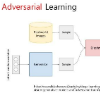Since radiologists have different training and clinical experience, they may provide various segmentation maps for a lung nodule. As a result, for a specific lung nodule, some regions have a higher chance of causing segmentation uncertainty, which brings difficulty for lung nodule segmentation with multiple annotations. To address this problem, this paper proposes an Uncertainty-Aware Segmentation Network (UAS-Net) based on multi-branch U-Net, which can learn the valuable visual features from the regions that may cause segmentation uncertainty and contribute to a better segmentation result. Meanwhile, this network can provide a Multi-Confidence Mask (MCM) simultaneously, pointing out regions with different segmentation uncertainty levels. We introduce a Feature-Aware Concatenation structure for different learning targets and let each branch have a specific learning preference. Moreover, a joint adversarial learning process is also adopted to help learn discriminative features of complex structures. Experimental results show that our method can predict the reasonable regions with higher uncertainty and improve lung nodule segmentation performance in LIDC-IDRI.
翻译:由于放射学家具有不同的培训和临床经验,他们可以为肺结核提供各种分解图,因此,对于特定的肺结核,有些区域更有可能造成分解不确定性,给肺结核分解带来多种注释的困难。为解决这一问题,本文件提议以多部门U-Net为基础,建立一个不确定-视觉分解网络(UAS-Net),这个网络可以学习可能造成分解不确定性和有助于更好分解结果的区域的宝贵视觉特征。与此同时,这个网络可以同时提供多侧面遮罩(MCM),指出分解不确定程度不同的区域。我们为不同的学习目标引入了地貌-视觉分解结构,让每个分支都有特定的学习偏好。此外,还采用了联合对抗学习过程,帮助学习复杂结构的歧视性特征。实验结果显示,我们的方法可以预测具有较高不确定性的合理区域,提高LIDRI的肺结核分解性。



